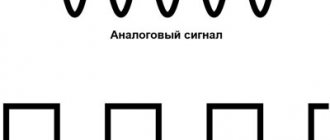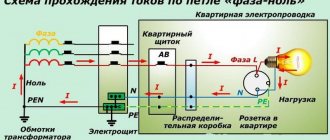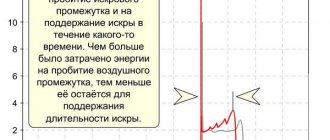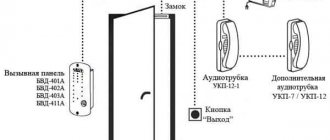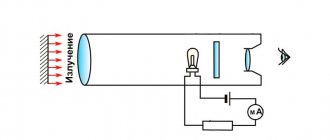In Dahl's dictionary
m. French a sign given for something, a message, a sign, a conventional sign (not verbally or in writing); The word lighthouse fully answers this. Make a signal, give, give a beacon, beacon; see lighthouse. Signal gun, rocket, conventional, beacon. Signal flags, naval conventional colors and arrangement of stripes, for giving signs lighthouse flags: the main ten, which can be used to indicate any number, number, with its conventional meaning. | Signal noun. and marine signalman. The lower rank assigned to this matter is the lighthouse. Signal, make signs, loom. Signature g. -Turk, pharmacy label on dispensed drugs, indicating the name of the medicine, or the name of the patient and the order of administration, etc. | A sign, a letter placed at the bottom of the first page of each printed sheet as a sign to the bookbinder. Signature label.
Private information
Signal and event
An event (receiving a note, observing a signal flare, receiving a symbol by telegraph) is a signal only in the system of relations in which the message is recognized as significant (for example, in combat conditions, a signal flare is an event that is significant only for the observer to whom it is addressed). It is obvious that a signal defined analytically is not an event and does not carry information if the function of the signal and its parameters are known to the observer.
In technology, a signal is always an event. In other words, an event - a change in the state of any component of a technical system, recognized by the logic of the system as significant, is a signal. An event that is not recognized by a given system of logical or technical relations as significant is not a signal.
Signal representation and spectrum
There are two ways to represent a signal depending on the domain of definition: time and frequency. In the first case, the signal is represented by a function of time {\displaystyle s(t)} characterizing the change in its parameter.
In addition to the usual temporal representation of signals and functions, the description of signals by frequency functions is widely used in data analysis and processing. Indeed, any signal, no matter how complex in its form, can be represented as a sum of simpler signals, and, in particular, as a sum of the simplest harmonic oscillations, the totality of which is called the frequency spectrum of the signal.
To switch to the frequency representation method, the Fourier transform is used:
.
The function is called spectral function or spectral density. Since the spectral function is complex, we can talk about the amplitude spectrum and phase spectrum.
The physical meaning of the spectral function: the signal is represented as the sum of an infinite series of harmonic components (sinusoids) with amplitudes continuously filling the frequency interval from to and initial phases.
The dimension of the spectral function is the dimension of the signal multiplied by time.
In radio engineering
In radio engineering, the main element of coding is signal modulation. In this case, a close to harmonic signal of the form s(t) = A sin(2πf t + φ) is usually considered, where the amplitude A, frequency f or phase φ slowly (relative to the rate of change of the sine) changes depending on the transmitted information (amplitude, frequency or phase modulation, respectively).
Stochastic signal models assume that either the signal itself or the information it carries is random. A stochastic signal model is often formulated as an equation relating the signal to noise, which in this case simulates the set of possible information messages and is called shaping noise, as opposed to nuisance observation noise.
A generalization of the scalar signal model are, for example, vector signal models, which are ordered sets of individual scalar functions, with a certain relationship of the vector components with each other. In practice, the vector model corresponds, in particular, to the simultaneous reception of a signal by several receivers with subsequent joint processing. Another extension of the concept of a signal is its generalization to the case of fields.
In Ozhegov's dictionary
SIGNAL, -a, m. 1. Conventional sign for transmitting something over a distance. information, messages. Sound, visual, light s, Writing s. P. 808 (from those in distress at sea; also translated: a call for help in trouble). 2. transfer That which serves as the impetus for the beginning of something. actions. The article served as a signal for discussion, 3. trans. Warning, message about something. unwanted. Listen to signals from the field. Signals from the public. || adj. signal, -th, -oe (to 1 value). Signal lights. Signal communication. C. pistol (rocket launcher). C. copy (the first, before circulation, finished copy of a printed work).
Types of signals
There are several types, as well as classifications of existing signals. Let's look at them.
The first type is an electrical signal, there are also optical, electromagnetic and acoustic. There are several other similar types, but they are not popular. This classification occurs according to the physical environment.
According to the method of setting the signal, they are divided into regular and irregular. The first type has an analytical function, as well as a deterministic type of data transfer. Random signals can be generated using some theories from higher mathematics, moreover, they are capable of taking on many values in completely different periods of time.
The types of signal transmission are quite different; it should be noted that signals according to this classification are divided into analog, discrete and digital. Often these signals are used to ensure the operation of electrical appliances. In order to understand each of the options, you need to remember the school physics course and read a little theory.
In Efremova's dictionary
Accent: signal m.
- A symbol for conveying something. information, orders, etc.
- That which serves as an impetus, an inducement to begin something. action, a call to smth.
Signal concept
back to contents
In the 18th century, the theory of mathematics included the concept of a function as a certain dependence of any quantity y
from another quantity - an independent variable
x
, with a mathematical representation of such a dependence in the form
y(x)
. Quite soon, the mathematics of functions became the basic basis for the theory of all natural and technical sciences. Functional mathematics has acquired particular importance in communications technology, where time functions of the form s(t), v(f), etc., used to transmit information, began to be called signals.
In technical branches of knowledge, the term “signal” (signal, from the Latin signum - sign) is very often used in a wide semantic range, without observing strict terminology. It is also understood as a technical medium for the transmission, circulation and use of information - an electrical, magnetic, optical signal; and a physical process, which is the material embodiment of an information message - a change in any parameter of the information carrier (voltage, frequency, power of electromagnetic oscillations, intensity of light flux, etc.) in time, in space or depending on changes in the values of any other arguments (independent variables); and the semantic content of a certain physical state or process, such as traffic lights, audible warning signals, etc. All these concepts are united by the final purpose of signals. This is certain information, messages, information about any processes, states or physical quantities of objects of the material world, expressed in a form convenient for transmission, processing, storage and use of this information.
The term “signal” is very often identified with the concepts of “data” and “information”. Indeed, these concepts are interrelated and do not exist one without the other, but belong to different categories.
The concept of information has many definitions, from the broadest (information is a formalized reflection of the real world) to the practical (information and data that are the object of storage, transmission, transformation, perception and management). Currently, world science is increasingly inclined to the point of view that information, along with matter and energy, belongs to the fundamental philosophical categories of natural science and refers to one of the properties of the objective world, although somewhat specific. As for “data” (from the Latin datum - fact), this is a set of facts, observational results, measurements about any objects, phenomena or processes of the material world, presented in a formalized form, quantitative or qualitative. This is not information, but only an attribute of information - raw material for obtaining information through appropriate processing and interpretation (interpretation).
Science and technology are international and use generally accepted terms, most of which are in English. The term “signal” in world practice is generally accepted to characterize the form of data presentation, in which the data is considered as the result of some measurements of the research object in the form of a sequence of values of scalar quantities (analog, numerical, graphic, etc.) depending on changes in any variable values (time, energy, temperature, spatial coordinates, etc.). mapping in some way
in a change in the physical state of any object - a material carrier of a signal, certain data about the nature of the change in space, time or any other variable of physical quantities, physical properties or the physical state of the research object. And since the data contains information both about the main target parameters of the research object, and about various accompanying and interfering measurement factors, then in the broad sense of the word we can consider that the signal is a carrier of general measurement information. In this case, the material form of the signal carriers (mechanical, electrical, magnetic, acoustic, optical and any other), as well as the form of display in any physical parameters or processes of the carriers, does not matter. An informative parameter of a signal can be any parameter of the signal carrier that is functionally associated with the values of information data.
A signal, in the most general sense, is the dependence of one quantity on another, and from a mathematical point of view it is a function. The most common representation of signals is in electrical form in the form of voltage versus time U(t). So, for example, a signal of a change in magnetic field strength along an aerial photography profile is both a time sequence of changes in the electrical voltage at the output of the aeromagnetometer sensor, and a recording of this voltage on the recorder tape, and sequential values of digital readings when processing the recorder tapes and inputting the signal into the computer.
A signal is an information function that carries a message about the physical properties, state or behavior of any physical system, object or environment, and the purpose of signal processing can be considered to be the extraction of certain information information that is displayed in these signals (in short - useful or target information) and transforming this information into a form convenient for perception and further use.
By “analysis” of signals we mean not only their purely mathematical transformations, but also drawing conclusions on the basis of these transformations about the specific features of the corresponding processes and objects. The goals of signal analysis are usually:
— Determination or evaluation of numerical parameters of signals (energy, average power, root mean square value, etc.).
— Decomposition of signals into elementary components to compare the properties of different signals.
— Comparison of the degree of proximity, “similarity,” “relatedness” of various signals, including with certain quantitative estimates.
The mathematical apparatus of signal analysis is very extensive and is widely used in practice in all areas of science and technology without exception.
registration is inextricably linked with the concept of a signal.
signals, the use of which is as broad and ambiguous as the term signal itself. In the most general sense, this term can be understood as the operation of isolating a signal and converting it into a form convenient for further use. Thus, when receiving information about the physical properties of any objects, signal registration is understood as the process of measuring the physical properties of the object and transferring the measurement results to the material carrier of the signal or the direct energy transformation of any properties of the object into information parameters of the material carrier of the signal (usually electrical ). But the term signal recording is also widely used for the processes of separating already formed signals carrying certain information from the sum of other signals (radio communications, telemetry, etc.), and for the processes of recording signals on long-term memory media, and for many other processes related with signal processing.
In relation to this course, the term registration will mean data registration
(data logging) that pass through a specific system or point in the system and are recorded in a certain way on some material medium or in the system memory.
As for the process of obtaining information using technical means that provide experimentally finding the ratio of the measured quantity with the standard unit of this quantity accepted by definition, and representing the measured ratio in some physical or numerical form of an information signal, then for this process we will mainly use detection
term .
back to contents
Did you know
that any reasonable person will say that there cannot be a smile without a cat and smoke without fire, there must be something warm out there in space, emitting EM waves, corresponding to a temperature of 2.7ºK. Indeed, the observed cosmic microwave radiation (CMB) is the thermal radiation of ether particles having a temperature of 2.7ºK. At the beginning of the twentieth century, the great chemists and physicists D.I. Mendeleev and Walter Nernst predicted that such radiation (temperature) should be detected in space. In 1933 prof. Erich Regener from Stuttgart measured this temperature using stratospheric probes. His measurements gave 2.8ºK - an almost exact modern value. Read more in the FAQ on ethereal physics.
In the dictionary D.N. Ushakova
SIGNAL, signal, male. (from Latin signum - sign). 1. An audio or visual symbol for transmitting over a distance a symbol for transmitting some information, orders, etc. over a distance. Marine signals. Railway signals. Give a signal. On signal. 2. transfer A warning about something undesirable that may happen, a warning (neol.). The Bolshevik Party requires sensitivity to signals coming from below, in the form of self-criticism. 3. A wooden structure erected at triangulation points during geodetic work (·geod.).
Signals by type of physical nature
Depending on the method of formation, the types of signals are as follows.
- Electrical (data carrier - time-varying current or voltage in an electrical circuit).
- Magnetic.
- Electromagnetic.
- Thermal.
- Signals of ionizing radiation.
- Optical/light.
- Acoustic (sound).
The last two types of signals are also the simplest examples of communication technical operations, the purpose of which is to notify about the peculiarities of the current situation.
Most often they are used to warn of danger or system malfunctions.
Often, sound and optical varieties are used as coordinating ones for the smooth operation of automated equipment. So some types of control signals (commands) are stimulating for the system to start acting.
For example, in fire alarms, when sensors detect traces of smoke, they emit a high-pitched sound. This, in turn, is perceived by the system as a control signal to extinguish the fire.
Another example of how a signal (types of signals by type of physical nature are listed above) activates the system in case of danger is the thermoregulation of the human body. So, if due to various factors the body temperature rises, the cells “inform” the brain about this, and it turns on the “body cooling system,” better known to everyone as sweating.
In the dictionary Dictionary of foreign words
a, m.
1. A conventional sign for transmitting some information or messages over a distance. Give s. Svetovoy village
A signalman is a person who gives signals. Signal - relating to a signal, signals. Signal - give signals.
2. trans. That which serves as an impetus for the beginning of some action. The article served as a signal for discussion.
3. trans. A warning, a message about something unwanted. Signals are being received from the localities about problems with supplies.
4. geod. A tower erected at a triangulation point, intended for the installation of geodetic instruments and for sighting from other points.
Share the meaning of the word:
Signal
Let's look at the types of communication signals a little later, but now you should get acquainted with what the signal itself is, in principle. This is a common code that is transmitted over the air by systems. This is a general type of formulation.
In the field of information and some other technologies, there is a special medium that allows messages to be transmitted. It can be created, but it cannot be accepted. In principle, some systems may accept it, but this is not required. If the signal is considered a message, then it is necessary to “catch” it.
Such a data transfer code can be called a regular mathematical function. It describes any change to the available parameters. If we consider radio engineering theory, it should be said that such options are considered basic. It should be noted that the concept of “noise” is similar to a signal.
It distorts it, can overlap with already transmitted code, and also represents a function of time itself. The article will describe signals and types of signals below; we are talking about discrete, analog and digital. Let's briefly consider the entire theory on the topic.



